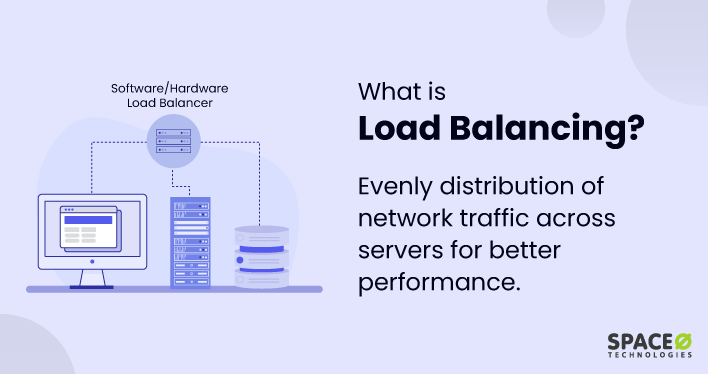Table of Contents
What is Load Balancing?
Load balancing refers to the process of evenly distributing incoming network traffic across multiple servers or resources to optimize performance, improve scalability, and ensure high availability. It aims to optimize performance, maximize resource utilization, and ensure high availability by intelligently distributing the workload.
Let’s explore the concept of load balancing and its benefits in more detail.
5 Core Benefits of Load Balancing in Network Infrastructure
Load balancing is an essential component of modern web application architecture and ensures that network traffic is efficiently distributed across multiple servers. Here are the core key benefits of using load balancing process:
Enhances Response Times and Reduces Latency
Load balancing optimizes response times and reduces latency. By evenly distributing incoming traffic across multiple servers, the load balancing method ensures that each server is efficiently utilized, preventing any single server from becoming overwhelmed. This results in improved performance and faster response times for end users.
Adapts to the Increasing Traffic Loads and User Demands
Load balancing handles the increasing traffic loads and accommodates growing user demands. As the volume of incoming requests increases, load balancing distributes the workload evenly across multiple servers, allowing the system to scale and handle the additional traffic effectively. This scalability ensures that the network infrastructure can handle peak loads without compromising performance.
Ensures Uninterrupted Service Availability
Load balancing ensures the high availability of services by monitoring the health and availability of backend servers. If a server becomes unresponsive or experiences a failure, the load balancer automatically redirects traffic to healthy servers. This seamless failover mechanism minimizes downtime and ensures that services remain accessible to users, even in the event of server failures.
Minimizes Downtime and Ensures Reliability
Load balancing provides redundancy by distributing traffic across multiple servers. In the event of a server failure, the load balancer redirects traffic to other healthy servers, ensuring continuous availability of services. This redundancy and failover mechanism minimizes downtime and enhances the reliability of the network infrastructure.
Maximizes Resource Efficiency and Reduces Cost
Load balancing optimizes resource utilization by evenly distributing the workload across multiple servers. This prevents any single server from being overloaded, maximizes resource efficiency, and extends the lifespan of the infrastructure. By efficiently utilizing available resources, load balancing reduces the need for additional hardware, resulting in cost savings for organizations.
Overall, load balancing enhances performance, scalability, availability, and resource utilization in network infrastructure. It ensures that services are accessible, responsive, and reliable, even during periods of high traffic. By efficiently managing and distributing the workload, cloud load balancing helps organizations meet user demands, minimize downtime, and optimize the utilization of their network resources.
How Load Balancing Works?
Load balancing works by distributing incoming network traffic across multiple servers or resources to ensure optimal resource utilization, improve performance, and enhance the availability of services.
Here’s a breakdown of how dynamic and static load balancing operates:
- Load balancing, performed by a load balancer, distributes incoming network traffic across multiple servers or resources.
- It ensures optimal resource utilization, improves performance, and enhances service availability.
- Load balancers use various algorithms to determine how traffic should be distributed.
- Health monitoring and session persistence mechanisms are used to maintain server availability and session continuity.
- Load balancing enables scalability, elasticity, and efficient management of network infrastructure.
A CDN also uses load balancing techniques to distribute traffic across multiple servers located in different regions to improve content delivery and ensure high availability. Now let’s learn about load balancing algorithms.
What are the Load Balancing Algorithms?
load balancing uses various load balancing algorithms and methods, with the help of load balancers to determine how incoming traffic should be distributed across servers or resources. Some commonly used load balancing techniques include:
- Round Robin: Incoming traffic is distributed sequentially to each server in rotation. With the help of load balancers, incoming traffic is evenly distributed across server infrastructure, ensuring that each server receives its fair share of requests. This approach helps to optimize resource utilization, prevent the overloading of individual servers, and promote a balanced workload distribution.
- Least Connection: Traffic is directed to the server with the fewest active connections, ensuring an even distribution of workload. By utilizing load balancers, no single server becomes overloaded with connections. Thus, it is easy to optimize performance and maintain a balanced workload across the server infrastructure.
- Weighted Distribution: Servers are assigned different weights based on their capacity or performance. The software load balancer or hardware load balancer distributes traffic proportionally according to these weights.
- Least Response Time: Traffic is routed to the server with the lowest response time, optimizing performance by sending requests to the fastest server. The load balancer plays a crucial role in implementing this load balancing technique, as they monitor the response times of servers and directs traffic accordingly.
- IP Hash: The load balancer calculates a hash value based on the source or destination IP address of the client. This value determines which server will handle the request, ensuring consistent routing for the same client.
These dynamic load balancing algorithms offer different strategies for load distribution, allowing organizations to choose the one that best suits their specific requirements and objectives.
Server load balancing is a critical component in network infrastructure, ensuring optimal performance, scalability, and availability of services. By evenly distributing incoming network traffic across multiple servers using hardware load balancers or software load balancers, the load balancing enhances response times, adapts to increasing traffic loads, and ensures uninterrupted service availability.
Load balancing solutions minimizes downtime, maximize resource efficiency, and reduce costs by efficiently utilizing available resources. With the help of hardware load balancers or software load balancers, organizations can effectively manage their network infrastructure, meet user demands, and optimize resource utilization.







